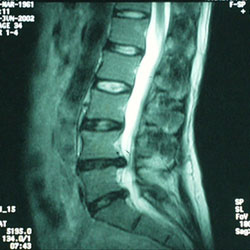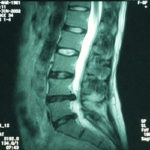So….do I need an MRI? Why advanced imaging at times does more harm then good

The following is a blog I had started a while ago that got lost and ultimately ignored in the black hole that is my computer. But then, a March 2015 article in the Journal of the American Medical Association brought this topic back to the forefront (1). The original impetus for this blog was an article that made waves as it was rapidly shared on social media sites (2). This particular article deserves an in depth summary, as wholesale changes are needed not just in how we order and interpret special imaging (MRI) but in how we perceive special imaging in general. This is part 1 of a 2 part blog on the epidemic of MRI overprescribing for musculoskeletal disorders
I have recently noticed a dramatic (and somewhat alarming) increased frequency in an inquiry by our patients during initial clinical encounters. Immediately after conveying our diagnosis (regardless what that diagnosis is), we get interrupted and asked:
“So…..should I get an MRI?”
This is like nails on a chalkboard to therapists. We can’t blame the patient. In fact, we don’t know where to place the blame. What we can do is identify two certainties (and I’ll prove them both).
1) Our healthcare system faces significant cost pressure, which will only get worse with increased demands due to our aging population demographics.
2) We are grossly overprescribing advanced imaging for musculoskeletal complaints, which is doing little but contributing to #1 above (along with fear mongering to many patients).
The impetus for this blog are three recent articles (1-3), all of which essentially say the same thing.
One for discussion is from the Spine Journal (2). Acute, work-related disabling low back pain was studied in 555 workers compensation claimants in the US across 45 states. Low back pain was grouped into 2 categories based on severity. People that had an MRI within the first 30 days of the onset of pain were then compared over the course of 2 years against those that did not have an MRI at all.
Now before explaining the results a couple of extremely pertinent points need mention.
1) Evidence informed Clinical Practice Guidelines recommend MRI for those with ‘red flags’ but not patients with non-specific low back pain in the short term.
2) The same guidelines suggest delaying imaging even in those with suspected significant back pain (like disc herniations or spinal stenosis) because up to 50% of these cases resolve through natural history in the first month. Only then is MRI indicated (after 1 month of conservative management) to help provide anatomic definition if surgery or injections are considered.
3) The above guidelines are ignored…..by almost everyone.
In fact, the rate of spine MRI’s in Medicare Beneficiaries increased by 307% over a recent 11 year period (and that is not just due to the increased cost of the imaging itself). Of the people in this study, 40.2% had a radiculopathy (pain down the leg), and of these 79.8% had an early MRI. Even the ‘nonspecific low back pain’ cases had a full 37% receiving an MRI in the first 30 days!
Now I know what you’re saying….”so what? I would want to know what is happening in my low back and what’s causing it.” The fallacy of this argument is really two fold. First, as you will see, MRI is not correlated with good patient outcomes (it’s actually quite the opposite). And second, despite MRI being sensitive (briefly – it is good at picking up patients that do have a condition), it is not specific (meaning it is not great at correctly identifying those without the condition). In fact, disc herniation and spinal stenosis are found in a full 20-57% of asymptomatic people! So 20-57% of people are walking around with what MRI would show as significant pathology, but with the patient having no pain whatsoever! So not only is MRI not well correlated with patient outcomes, it is not even well correlated with a patient’s symptoms.
 (this is an example of a lumbar disc herniation on MRI…..who knows if this person even is in pain?).
(this is an example of a lumbar disc herniation on MRI…..who knows if this person even is in pain?).
So how did the participants in this study fare? Here are the pertinent results: The early MRI group when compared with the no MRI group had:
1) Greater pre-MRI medical costs
2) Higher Morphine Equivalent Amounts (opioid prescriptions) in the first 15 days
3) Significantly longer lengths of disability regardless of severity (radiculopathy or not)
4) SIGNIFICANTLY higher total medical costs (average was 13-14,000 higher) – even for those whose pain resolved quite quickly.
5) On average: the rate of getting OFF disability for those with an early MRI was roughly 33% the rate of those who did not receive an MRI.
6) In both groups, the receipt of an early MRI (within the first 30 days) was correlated with worse outcomes, even after controlling for severity and demographic features.
7) Post MRI costs 8000 higher on average then the no MRI group, yet there was no evidence of better outcomes (again, regardless of severity)
Holy crap!
So why were early MRI’s ordered when we know the recommendation in acute low back pain is to pursue conservative care because most cases resolve within 4-6 weeks? The researchers had a few suggestions
1) The perceived severity of a radiculopathy (pain down the leg)
2) Patient requests/persistence
3) Desire to allay or satisfy patient fears
4) Economic incentives
5) Provider concerns
The issue is that instead of MRI providing reassurance, the patients tend to develop a decreased sense of well-being. Further, the researchers note that as MRI technology continues to improve, the resolution gets better and we are seeing things that are read as abnormalities, which set off a cascade of additional testing, which are misinterpreted as abnormal, and erroneously attributed to the patient’s pain. This further increases specialist referrals, and even interventions (surgery included) that have no improvement in patient outcomes.
Do we regularly refer for MRI? Absolutely. But only when better indicated (more on our personal belief in blog 2).
So what have we learned? A few take home points:
1) We are ignoring Clinical Practice Guidelines by overprescribing special imaging. This is not just related to the low back as you will see in Part 2 of this blog.
2) A 2009 Systematic Review of high(ish) quality trials found no benefit in health, function or disability outcomes with early MRI in low back pain (4).
3) A great summary from the article itself: the greater medical use in early MRI shows it may be the first of a cascade pattern of care characterized by over-prescribing, overtesting, intensive and ineffective treatment and ultimately poor outcomes.
The term ‘iatrogenic’ means a preventable harm stemming from an examination or treatment. Enough said.
- Jarvik JG, Gold LS et al. Association of early imaging for back pain with clinical outcomes in older adults. JAMA 2015;313(11):1143-1153
- Webster BS, Bauer AZ, et al. Iatrogenic consequences of early magnetic resonance imaging in acute, work-related, disabling low back pain. Spine 2013;38(22):1939-46
- Graves JM, Fulton-Kehoe D et al. Early imaging for acute low back pain: one year health and disability outcomes among Washington State workers. Spine 2012;37(18):1617-27
- Chou R, Fu R et al. Imaging strategies for low back pain: systematic review and meta-analysis. Lancet 2009;373:463-72
